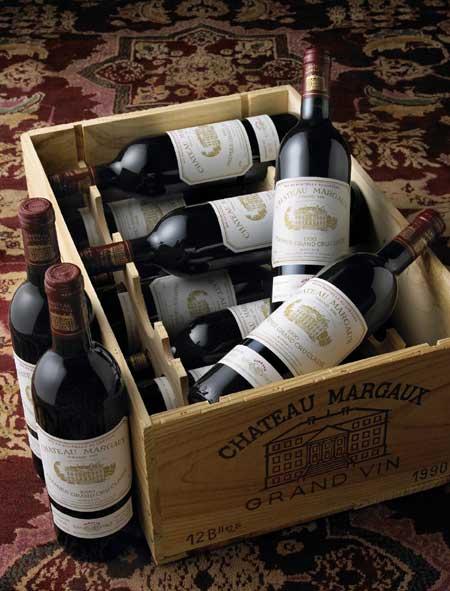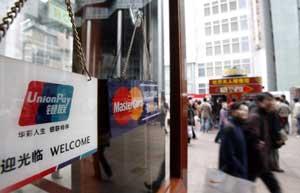
Bottles of 1990 Chateau Margaux on show at a recent auction in Hong Kong. An increasing number of Chinese business people have become wine collectors for investment purposes as well as pleasure. Provided to China Daily
Investors discover wine produces much better yields than ever beforeBEIJING - In addition to investing in stocks, real estate and antiques, Chinese billionaires are discovering a new source of big returns - the wine market. The yield rate from some famous French vintages during the first half of this year has exceeded 30 percent, far above any alternative.
The price of historic and exclusive Chateau Lafite Rothschild, from Bordeaux in France and the most popular wine brand in China, is rising monthly. In July, one bottle of the 2007 vintage cost 4,500 yuan. It jumped to 5,000 yuan in August and is expected to exceed 6,000 yuan with the Mid-Autumn Festival and National Day holiday around the corner.
"The wine market is new in China and has the most potential," said Jiang Yu, a private vineyard owner who used to be a professional real estate investor. He followed his nose and the money into the more profitable wine industry after the Chinese government tightened property policies this year.
Jin Cunxing from Wenzhou, in East China's Zhejiang province, who is also a former property investor, traveled to Bordeaux six months ago to buy hundreds of bottles of Chateau Lafite Rothschild.
He said: "I don't know where all these Chinese buyers have come from. The peak season isn't here yet but the price of vintage wines has increased 30 percent this year."
Since there is no general agent for importing foreign wines in China, the number of wine dealers has taken off very fast.
According to Guangzhou Boboqiu Wine Co Ltd, one of the biggest vintage wine importers in China, more than 20 dealers entered the business just between June and August this year.
Xu Weibo, general manager of Hong Kong Fine Wine Auction Limited, told China Daily that the company, founded in November 2009, aimed to provide a marketplace for wine enthusiasts, collectors and sellers to acquire or sell fine and rare wines on the Internet. It estimates up to 60 percent of wine traded on its website ends up on the Chinese mainland.
Xu is a wine collector for investment as well as pleasure. When he swirls wine in a goblet, you could say he is actually managing his assets.
"We have invested in some 60 different fine wine brands around the world worth a total of HK$100 million ($13 million)," said Xu.
"I believe the average annual rate of return will range from 20 percent to 30 percent."
With more than four years of wine investment experience, Xu said investors should first master good knowledge of wine culture and collection as well as wine investment skills, and then enter the business cautiously.
"In the wine world, the ones that are worth collecting and investing in only account for 0.1 percent of the total," he said.
There are mainly two ways to carry out wine investment: buy the actual product or buy wine futures (also known as "en primeur").
Both of them tend to be long-term investments in the western world but the current behavior in China is more like hot money speculation.
En primeur is a method of purchasing wines early while a vintage is still in a barrel, offering the customer the opportunity to invest in a particular wine before it is bottled. Payment is made at an early stage, a year or 18 months prior to the official release of a vintage.
In general, wines are much cheaper during the en primeur period than they will be once bottled and released on the market. Also, the winery could hedge their costs by the income from selling en primeur.
Investing in en primeur is getting more and more popular in China. There is now a saying among Chinese buyers: "Buy two cases of en primeur. Drink one and have another two for free." It means the appreciation of one case vintage could pay for two extra cases.
In July, speculators put the price of Chateau Lafite Rothschild en primeur 2009 at nearly 1,000 euros ($1,288) per bottle, double the release price.
As the big returns became clear, Chinese local wine manufacturers also rushed into the "liquid gold" business.
Chateau Changyu Afip Global, a subsidiary company of the biggest wine producer in China and Asia - Yantai Changyu Pioneer Wine Company Limited - has just sold its 2009 en primeur at 270,000 yuan per barrel.
A total of 300 barrels were sold directly to the Industrial and Commercial Bank of China (ICBC) private banking customers as a financing product with an annualized yield of 5 percent.
Analysts said that its yield to maturity might exceed 20 percent after 18 months when the wines are being bottled.
It is a rich person's game. ICBC private banking customers must have at least 8 million yuan each in their ICBC's personal accounts.
The first en primeur in China, Changyu en primeur 2006, which was sold at 180,000 yuan per barrel, is worth 288,000 yuan now. Its biggest buyer, TxB International Fine Wines, a German company, turned in a handsome profit by purchasing 20 percent of the total production of 100 barrels.
After Changyu, Chateau Junding, located in Penglai, Shandong province, also began to sell en primeur in cooperation with ICBC, China Citic Bank and China Merchants Bank.
Although the popularity of wine investment has grown by leaps and bounds in China, some analysts are worried that Chinese wine investors are creating a global bubble, forcing buyers all over the world to pay more.
Andy Xie, a Shanghai-based independent economist formerly with Morgan Stanley, said in a recent column for Century Weekly Magazine that "as the French fine wine index (Liv-100 index) is up by roughly 37 percent from a year ago, 24 percent year-to-date, there is little doubt that Chinese buyers, not Wall Street traders, are the force behind this positive trajectory for French fine wine".
He added there was a particular bubble surrounding Chateau Lafite Rothschild's second label, Carruades de Lafite, or little Lafite in Chinese.
 Stem trade disputes, China urges US
Stem trade disputes, China urges USThe Carruades de Lafite is made of grapes from young vines in the famed Lafite winery. It should be much cheaper than the second-class vintage, not to mention the first-class.
Confused by the "Lafite" title, the Chinese market is pushing up the price of Carruades de Lafite to 2,000 pounds sterling per case, an increase of roughly 10 times since 2005. Its price sometimes rivals the prices of non-Lafite first-class wines and is usually higher than great second-class wines.
"It's an insult to first-class vintages and the long history of the wine industry in the western world," Xie said.
"A market is efficient when informed consumers make rational choices. An efficient market motivates producers to improve quality and control costs and this cycle leads to great brands that last. The French wine market was like that, but I am afraid that the Chinese demand is decreasing the market efficiency and may bring down great brands over time."
Ben Yue contributed to the story.





